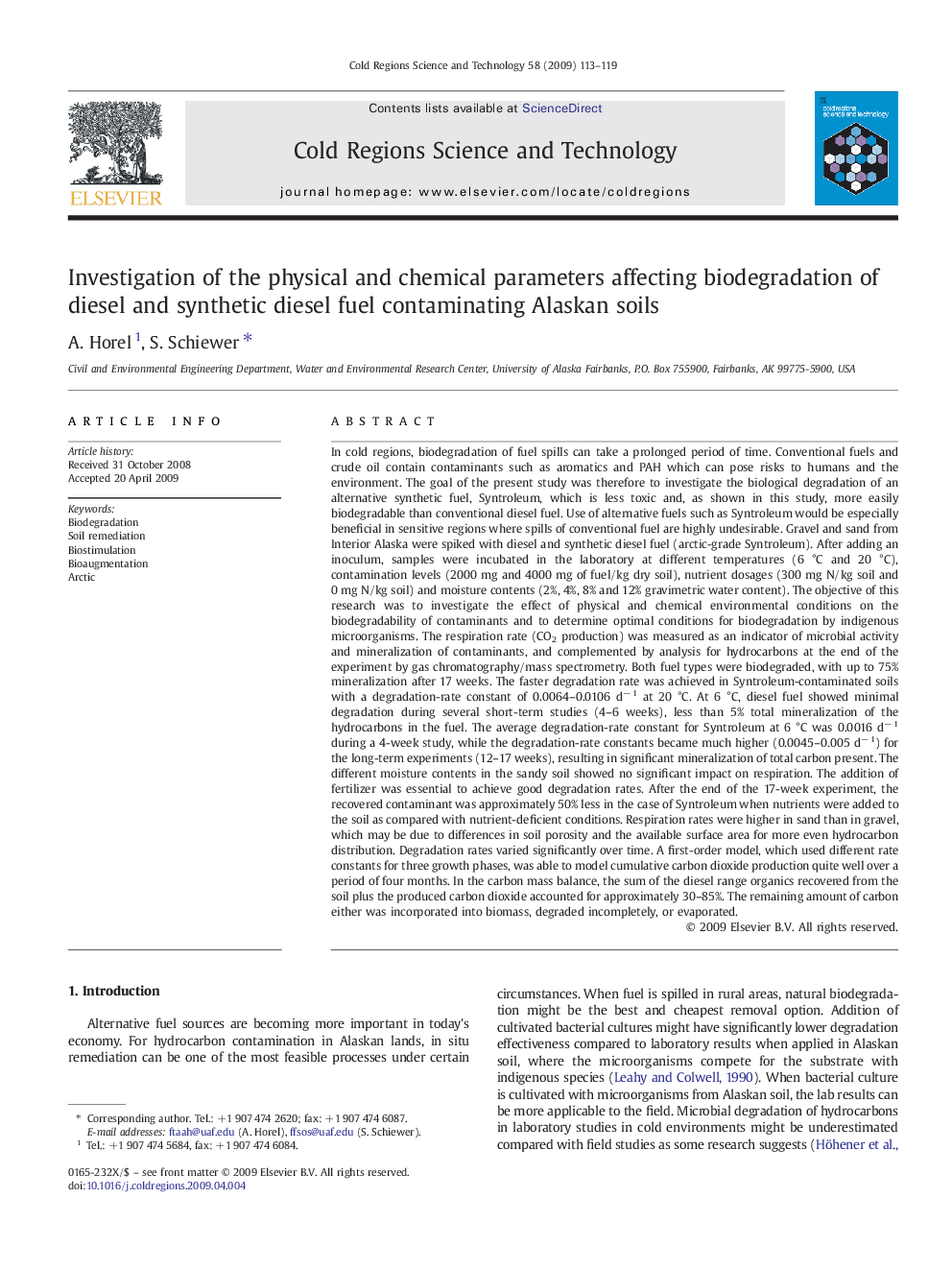| کد مقاله | کد نشریه | سال انتشار | مقاله انگلیسی | نسخه تمام متن |
|---|---|---|---|---|
| 4676450 | 1347760 | 2009 | 7 صفحه PDF | دانلود رایگان |

In cold regions, biodegradation of fuel spills can take a prolonged period of time. Conventional fuels and crude oil contain contaminants such as aromatics and PAH which can pose risks to humans and the environment. The goal of the present study was therefore to investigate the biological degradation of an alternative synthetic fuel, Syntroleum, which is less toxic and, as shown in this study, more easily biodegradable than conventional diesel fuel. Use of alternative fuels such as Syntroleum would be especially beneficial in sensitive regions where spills of conventional fuel are highly undesirable. Gravel and sand from Interior Alaska were spiked with diesel and synthetic diesel fuel (arctic-grade Syntroleum). After adding an inoculum, samples were incubated in the laboratory at different temperatures (6 °C and 20 °C), contamination levels (2000 mg and 4000 mg of fuel/kg dry soil), nutrient dosages (300 mg N/kg soil and 0 mg N/kg soil) and moisture contents (2%, 4%, 8% and 12% gravimetric water content). The objective of this research was to investigate the effect of physical and chemical environmental conditions on the biodegradability of contaminants and to determine optimal conditions for biodegradation by indigenous microorganisms. The respiration rate (CO2 production) was measured as an indicator of microbial activity and mineralization of contaminants, and complemented by analysis for hydrocarbons at the end of the experiment by gas chromatography/mass spectrometry. Both fuel types were biodegraded, with up to 75% mineralization after 17 weeks. The faster degradation rate was achieved in Syntroleum-contaminated soils with a degradation-rate constant of 0.0064–0.0106 d− 1 at 20 °C. At 6 °C, diesel fuel showed minimal degradation during several short-term studies (4–6 weeks), less than 5% total mineralization of the hydrocarbons in the fuel. The average degradation-rate constant for Syntroleum at 6 °C was 0.0016 d− 1 during a 4-week study, while the degradation-rate constants became much higher (0.0045–0.005 d− 1) for the long-term experiments (12–17 weeks), resulting in significant mineralization of total carbon present. The different moisture contents in the sandy soil showed no significant impact on respiration. The addition of fertilizer was essential to achieve good degradation rates. After the end of the 17-week experiment, the recovered contaminant was approximately 50% less in the case of Syntroleum when nutrients were added to the soil as compared with nutrient-deficient conditions. Respiration rates were higher in sand than in gravel, which may be due to differences in soil porosity and the available surface area for more even hydrocarbon distribution. Degradation rates varied significantly over time. A first-order model, which used different rate constants for three growth phases, was able to model cumulative carbon dioxide production quite well over a period of four months. In the carbon mass balance, the sum of the diesel range organics recovered from the soil plus the produced carbon dioxide accounted for approximately 30–85%. The remaining amount of carbon either was incorporated into biomass, degraded incompletely, or evaporated.
Journal: Cold Regions Science and Technology - Volume 58, Issue 3, September 2009, Pages 113–119